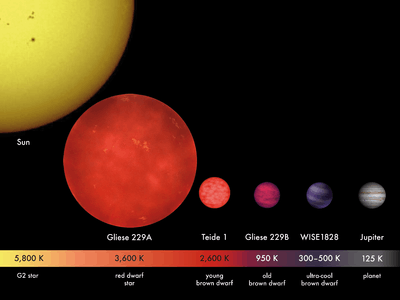Jupiter mass

Jupiter mass (MJ or MJup) is the unit of mass equal to the total mass of the planet Jupiter (1.898×1027 kg, 317.83 Earth mass;[1] one Earth mass equals 0.00315 Jupiter masses). Jupiter mass is used to describe masses of the gas giants, such as the outer planets and extrasolar planets. It is also used in describing brown dwarfs.
The most massive exoplanets are typically described in terms of Jupiter masses as this provides a convenient scale for comparison. A Jupiter-mass planet at an orbital distance of 1 AU from a Sun-like star causes an amplitude shift of 28 m/s, which is detectable with current technology.[2] The most readily detectable planets through radial velocity measurements have high mass and close orbits. This produces a selection effect for planets of Jupiter mass. Likewise, Jupiter mass or higher planets are more likely to be detected through other means, such as transits or microlensing.[3]
A planet with a Jupiter mass might not have the same dimensions. The theoretical minimum mass a star can have, and still undergo hydrogen-1 fusion at the core, is estimated to be about 75 times the mass of Jupiter, while fusion of deuterium can occur at masses as low as 13 Jupiters.[4][5][6]
In the Solar System, the masses of the outer planets can be listed in Jupiter mass. The other gas giants are far less massive than Jupiter.
One Jupiter mass can be converted to related units:
- 25,839 Lunar mass (ML)
- 317.83 Earth mass (M⊕)[1]
- 0.0009546 Solar mass (M☉)
In comparison, one Solar mass is equivalent to:
- 27,068,500 Lunar mass (ML)
- 332,946 Earth mass (M⊕)
- 1,047.56 Jupiter mass (MJ)
Jupiter comprises roughly three-quarters of the mass of the solar system excluding the Sun.
| Planet | Mercury | Venus | Earth | Mars | Jupiter | Saturn | Uranus | Neptune |
|---|---|---|---|---|---|---|---|---|
| Earth mass M⊕ | 0.06 | 0.82 | 1 | 0.11 | 317.8 | 95.2 | 14.6 | 17.2 |
| Jupiter mass MJ | 0.000 17 | 0.002 56 | 0.003 15 | 0.000 34 | 1 | 0.299 | 0.046 | 0.054 |
See also
References
- 1 2 Williams, Dr. David R. (2 November 2007). "Jupiter Fact Sheet". NASA. Retrieved 2009-07-16.
- ↑ Kovalevsky, Jean; Seidelmann, P. Kenneth (2004). Fundamentals of Astrometry. Cambridge University Press. p. 346. ISBN 0-521-64216-7.
- ↑ Jones, Barrie William (2004). Life in the solar system and beyond. Springer. pp. 211–233. ISBN 1-85233-101-1.
- ↑ Boss, Alan (2001-04-03). "Are They Planets or What?". Carnegie Institution of Washington. Archived from the original on 2006-09-28. Retrieved 2006-06-08.
- ↑ Shiga, David (2006-08-17). "Mass cut-off between stars and brown dwarfs revealed". New Scientist. Retrieved 2006-08-23.
- ↑ Basri, Gibor (2000). "Observations of Brown Dwarfs". Annual Review of Astronomy and Astrophysics. 38: 485. Bibcode:2000ARA&A..38..485B. doi:10.1146/annurev.astro.38.1.485.
